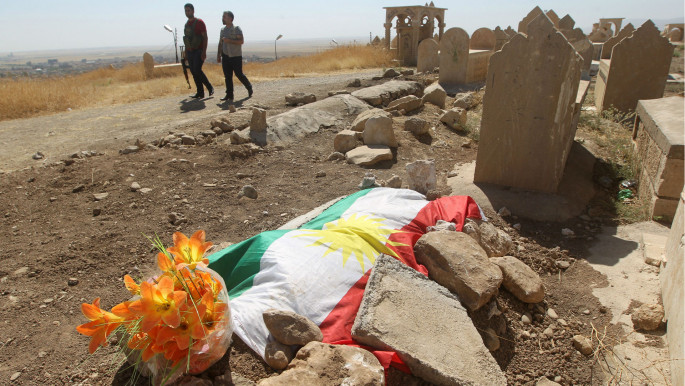Sinjar, the mountain of graves
When Kurdish militants entered the newly liberated Iraqi town of Sinjar in November, they must have been prepared to witness Biblical scenes of massacre and torture.
Islamic State group fighters had captured the town in August 2014, and proceeded to round up and murder between 2,000 and 5,000 of Sinjar's male population.
Since then, many other massacres of Yazidi have taken place, but the jigsaw of clues as to what happened here may never be complete.
Slavery and murder
Sinjar is unique in that the majority of residents come from Iraq's Yazidi religious and ethnic community.
For centuries they have lived in relative isolation from for their neighbours, leading many Muslims to view them - wrongly - as "devil worshippers".
This comes from their veneration of a peacock angel, named Malek Taus. The path he is said to have taken in life and that of the devil often overlap in Abrahamic religions.
When IS captured Sinjar, the persecution of the Yazidi intensified.
Young women and girls were sold as sex slaves and domestic workers.
It was only when Kurdish fighters poured into Sinjar on 13 November that the whole picture of IS war crimes became clearer.
Six mass graves have been found around the town since it was liberated two weeks ago. The victims - or at least some of them - were women that IS militants viewed as being too old to marry, and so they were simply murdered.
Iraq's Yazidi community has every reason to believe that what they have experienced at the hands of the extremists could be classified as genocide.
 |
| Thousands of Yazidis have died from murder, starvation and disease [AFP] |
But proving it might be difficult, given the careless treatment of the grave sites when Kurdish fighters discovered them.
"We are really concerned by the lack of evidence or professional examination of these sites," fears Christoph Wilcke, senior Middle East researcher with Human Rights Watch.
Al-Araby al-Jadeed spoke to Wilcke in August after he had visited areas around Sinjar Mountain that had recently been captured from IS.
There, Kurdish fighters and local Yazidi militias discovered a number of mass graves.
When Wilcke arrived on the scene, he saw the grave sites open to the public. Loved ones of the victims were allowed to pick up the bones and take the remains away for burial, before a proper investigation could be carried out.
Vital evidence had been corrupted, which could mean that we will never know how or why these people died. Essentially, justice has been buried with them.
The same is happening again at the new mass graves discovered in Sinjar town.
"There certainly needs to be a more careful examination of the graves," Wilcke said, speaking from Erbil.
| Read more: Investigating the murders of the Sinjar mountains |
"Since the first mass graves became publicly accessible on the Kurdish side there has not been one internationally renowned expert on mass grave investigations brought to this region to assist the Kurdish authorities."
The grave sites are also poorly guarded. He has heard of only one crime scene having yellow paper ringing it, while the rest have no clear demarkation at all.
"Journalists and family members can come and touch or take away [the bones]. It is the same as before and they will all be gone."
Often, the identities of the victims are unclear.
|
|
Graves often include dozens of badly decomposed bodies. Those buried could include local Sunni Arabs, Christians, Shia Turkmen - even IS fighters killed in air raids - along with Yazidi victims.
"We would need to esablish that IS members were there, because [the killers] could have been someone else. It needs a proper judicial investigation, but a lot of this will be gone when people just trample all over the crime site," said Wilcke.
This means that Yazidi claims of genocide could be lost as these mass graves are dug up and the remains buried elsewhere.
Wilcke said that the fact these claims could be very likely true make it even more imperative that cases are investigated correctly.
"Why are [they] not doing a proper job in documenting what could well be genocide and destroying evidence that reaches that conclusion?
"We shouldn't only think of getting the guys who [committed the killings] behind bars, but also get justice in the broader sense and accountability for family members."
The international community also needs to provide the right expertise and appropriate finances to make this happen, said Wilcke.
However, the areas are run by a multitude of rival militias, although groups linked to the Kurdistan Democratic Party appear to the strongest.
"There are a variety of people there... but there are also turf wars between them," he said.
Iraqi Kurdish leader Masoud Barzani has been under attack by non-KDP groups for claiming his allied Peshmerga units solely liberated Sinjar.
This has angered Yazidi and other Kurdish militias who also played a crucial role in capturing the town from IS.
Barzani has also claimed that Sinjar will remain "Kurdish", making many to believe that the Kurdish leader was driven by the desire to grab land rather than to free the Yazidi.
Only when rival Kurdish parties and militias come together can an environment be created that would allow forensic work to take place. Only then will the Yazidi to get the closure - and justice - they deserve.
Follow Paul McLoughlin on Twitter: @pmcloughlin9





 Follow the Middle East's top stories in English at The New Arab on Google News
Follow the Middle East's top stories in English at The New Arab on Google News


